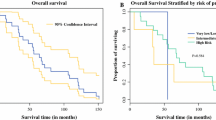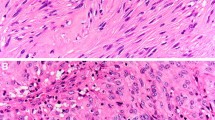Abstract
Purpose
Gastrointestinal stromal tumors (GISTs) are the most common soft tissue tumors of the GI tract. Studies have been published reporting additional neoplasms in GIST patients. This study aimed to evaluate possible associations of mutation type, morphology, and clinical aspects of GISTs.
Methods
All cases of GIST were identified from our pathology files. Coding exons of KIT and PDGFRA in GISTs with additional malignancies were sequenced.
Results
A total of 70 of 188 (37%) retrieved patients with confirmed diagnosis of GIST showed at least one additional malignant neoplasm. Fifty of these GISTs were located in the stomach (71%), 8 in the small intestine (11%), 5 in the colon/rectum (7%), and 7 cases (6.2%) were of undetermined sites of origin. The distribution of identified mutations was similar to that described in GISTs without secondary malignancies. A total of 37 of 57 cases (65%) showed mutations in the KIT gene exon 11, 3 (5%) cases in exon 9, and 1 (2%) case in exon 13. Nine tumors (16%) had mutations of the PDGFRA gene. KIT and PDGFRA wild-type status were found in seven cases (12%). Most of the secondary neoplasms were located within the GI tract (34%), in the urogenital system (24%), or the breast/female genital tract (20%).
Conclusion
This study confirms the high rate of additional malignant tumors in GIST patients. GIST features in these cases are very similar to those with sole GIST.


Similar content being viewed by others
References
Agaimy A, Wünsch PH, Sobin LH, Lasota J, Miettinen M (2006) Occurrence of other malignancies in patients with gastrointestinal stromal tumors. Semin Diagn Pathol 23:120–129
Aghdassi A, Christoph A, Dombrowski F, Döring P, Barth C, Christoph J, Lerch MM, Simon P (2018) Gastrointestinal stromal tumors: clinical symptoms, location, metastasis formation, and associated malignancies in a single center retrospective study. Dig Dis 36:337–345
Amankwah EK, Conley AP, Reed DR (2013) Epidemiology and therapies for metastatic sarcoma. Clin Epidemiol 5:147–162
Corless CL, Barnett CM, Heinrich MC (2011) Gastrointestinal stromal tumours: origin and molecular oncology. Nat Rev Cancer 11:865–878
Dumont AG, Rink L, Godwin AK, Miettinen M, Joensuu H, Strosberg JR, Gronchi A, Corless CL, Goldstein D, Rubin BP, Maki RG, Lazar AJ, Lev D, Trent JC, von Mehren M (2012) A nonrandom association of gastrointestinal stromal tumor (GIST) and desmoid tumor (deep fibromatosis): case series of 28 patients. Ann Oncol 23:1335–1340
Fernández JA, Olivares V, Gómez-Ruiz AJ et al (2018) Additional malignancies in patients with gastrointestinal stromal tumors (GIST): incidence, pathology and prognosis according to a time of occurrence-based classification. Clin Transl Oncol. https://doi.org/10.1007/s12094-018-1966-5
Goncalves R, Linhares E, Albagli R et al (2010) Occurrence of other tumors in patients with GIST. Surg Oncol 19:e140–e143
Hechtman JF, Dematteo R, Nafa K et al (2015) Additional primary malignancies in patients with gastrointestinal stromal tumor (GIST): a clinicopathologic study of 260 patients with molecular analysis and review of the literature. Ann Surg Oncol 22:2633–2639
Hirota S, Isozaki K, Moriyama Y et al (1998) Gain-of-function mutations of c-kit in human gastrointestinal stromal tumors. Science 279:577–580
Joensuu H, Eriksson M, Hall KS, Hartmann JT, Pink D, Schütte J, Ramadori G, Hohenberger P, Duyster J, al-Batran SE, Schlemmer M, Bauer S, Wardelmann E, Sarlomo-Rikala M, Nilsson B, Sihto H, Ballman KV, Leinonen M, DeMatteo RP, Reichardt P (2014) Risk factors for gastrointestinal stromal tumor recurrence in patients treated with adjuvant imatinib. Cancer 120:2325–2333
Kramer K, Wolf S, Mayer B, Schmidt SA, Agaimy A, Henne-Bruns D, Knippschild U, Schwab M, Schmieder M (2015) Frequence, spectrum and prognostic impact of additional malignancies in patients with gastrointestinal stromal tumors. Neoplasia 17:134–140
Mendonca SJ, Sanchez A, Blum KA, Ghanaat M, Kashan MY, Benfante N, Russo P, Coleman JA, Crago AM, Hakimi AA (2018) The association of renal cell carcinoma with gastrointestinal stromal tumors. J Surg Oncol 117:1716–1720
Miettinen M, Lasota J (2006) Gastrointestinal stromal tumors: review on morphology, molecular pathology, prognosis, and differential diagnosis. Arch Pathol Lab Med 130:1466–1478
Miettinen M, Sobin LH, Lasota J (2005) Gastrointestinal stromal tumors of the stomach: a clinicopathologic, immunohistochemical, and molecular genetic study of 1765 cases with long-term follow-up. Am J Surg Pathol 29:52–68
Miranda C, Nucifora M, Molinari F, Conca E, Anania MC, Bordoni A, Saletti P, Mazzucchelli L, Pilotti S, Pierotti MA, Tamborini E, Greco A, Frattini M (2012) KRAS and BRAF mutations predict primary resistance to imatinib in gastrointestinal stromal tumors. Clin Cancer Res 18:1769–1776
Murphy JD, Ma GL, Baumgartner JM, Madlensky L, Burgoyne AM, Tang CM, Martinez ME, Sicklick JK (2015) Increased risk of additional cancers among patients with gastrointestinal stromal tumors: a population-based study. Cancer 121:2960–2967
Nilsson B, Bumming P, Meis-Kindblom JM et al (2005) Gastrointestinal stromal tumors: the incidence, prevalence, clinical course, and prognostication in the preimatinib mesylate era—a population-based study in western Sweden. Cancer 103:821–829
Pandurengan RK, Dumont AG, Araujo DM, Ludwig JA, Ravi V, Patel S, Garber J, Benjamin RS, Strom SS, Trent JC (2010) Survival of patients with multiple primary malignancies: a study of 783 patients with gastrointestinal stromal tumor. Ann Oncol 21:2107–2111
Rodriquenz MG, Rossi S, Ricci R, Martini M, Larocca M, Dipasquale A, Quirino M, Schinzari G, Basso M, D’Argento E, Strippoli A, Barone C, Cassano A (2016) Gastrointestinal stromal tumors (GISTs) and second malignancies: a novel “sentinel tumor”? A monoinstitutional, STROBE-compliant observational analysis. Medicine (Baltimore) 95:e4718
Rubio-Casadevall J, Borras JL, Carmona-Garcia MC et al (2015) Correlation between mutational status and survival and second cancer risk assessment in patients with gastrointestinal stromal tumors: a population-based study. World J Surg Oncol 13:47
Smith MJ, Smith HG, Mahar AL, Law C, Ko YJ (2016) The impact of additional malignancies in patients diagnosed with gastrointestinal stromal tumors. Int J Cancer 139:1744–1751
Tran T, Davila JA, El-Serag HB (2005) The epidemiology of malignant gastrointestinal stromal tumors: an analysis of 1,458 cases from 1992 to 2000. Am J Gastroenterol 100:162–168
Vassos N, Agaimy A, Hohenberger W, Croner RS (2014) Coexistence of gastrointestinal stromal tumours (GIST) and malignant neoplasms of different origin: prognostic implications. Int J Surg 12:371–377
Acknowledgments
We would like to thank Mrs. Monika Müller and Mr. Kai Hebick, both at clinical center Augsburg, for the acquisition of paraffin-embedded tissue and data management as well as Mrs. Ingrid Mons, Department of Pathology of the University of Erlangen, for the support in molecular analysis.
Funding
This study was financially supported by Novartis AG. There was no influence on the study design, aim, or data analysis.
Author information
Authors and Affiliations
Contributions
Patrick Mayr: study design, data acquisition and interpretation, manuscript drafting. Bruno Märkl: manuscript drafting and study design.Abbas Agaimy: manuscript drafting and data interpretation. Bernadette Kriening: data acquisition. Sebastian Dintner: data analysis and data acquisition. Gerhard Schenkirsch: data acquisition. Regine Schneider-Stock: study design, data acquisition and interpretation, and manuscript drafting.
Corresponding author
Ethics declarations
This study was approved by the ethical board of Klinikum Augsburg.
Conflict of interest
The authors declare that they have no conflict of interest.
Additional information
Publisher’s note
Springer Nature remains neutral with regard to jurisdictional claims in published maps and institutional affiliations.
Rights and permissions
About this article
Cite this article
Mayr, P., Märkl, B., Agaimy, A. et al. Malignancies associated with GIST: a retrospective study with molecular analysis of KIT and PDGFRA. Langenbecks Arch Surg 404, 605–613 (2019). https://doi.org/10.1007/s00423-019-01773-2
Received:
Accepted:
Published:
Issue Date:
DOI: https://doi.org/10.1007/s00423-019-01773-2




